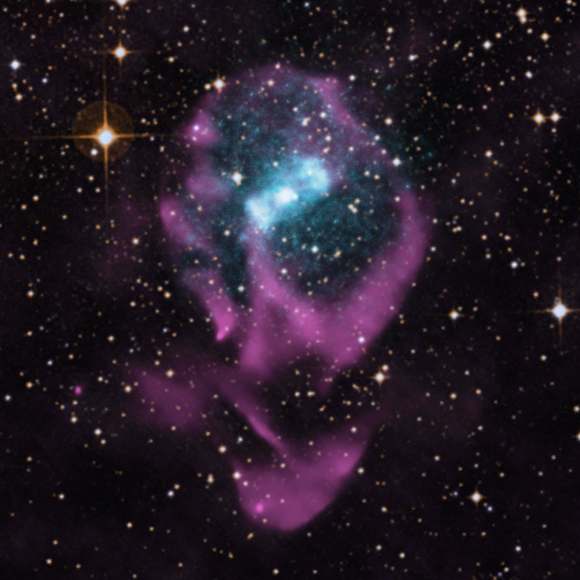An artist’s idea of Circinus X-1 and its jet. Inset is an X-ray image of the source.
Credit: Artwork: NASA/CXC/M.Weiss; X-ray image: NASA/CXC/Univ. of Wisconsin-Madison/S.Heintz et al.
The Compact Array has just helped a neutron star take years off its age.
So much so that we think the star is little more than a newborn, less than 5000 years old.
Huh?
Circinus X-1 is what’s called an X-ray binary: a neutron star in mutual orbit around a ‘regular’ companion star. From time to time matter rains down on the neutron star from the companion, causing flares of X-rays and radio waves.
Circinus X-1 also has a pair of ‘jets’, like those from a black hole.
This stellar couple is one of the brightest X-ray sources in the sky. It was discovered in 1969, and has been studied for years.
But it still held a surprise.
The binary system is surrounded by a faint fog of ‘stuff’ emitting radio waves.
For years astronomers thought this fog was created by the system’s ‘jets’.
But thanks to new work with the Compact Array and NASA’s Chandra X-ray space telescope, researchers have decided that the ‘fog’ is actually a supernova remnant — the remains of the star that exploded and created the neutron star.
Composite image of Circinus X-1, which is about 24,000 light-years from Earth in the constellation Circinus. X-rays are in blue and radio waves in purple.
Credit: X-ray: NASA/CXC/Univ. of Wisconsin-Madison/S. Heinz et al; Optical: DSS; Radio: CSIRO/ATCA
Supernova remnants don’t last very long, so that means the explosion happened recently (in astronomers’ terms!).
By estimating the temperature of the remnant, and making some assumptions about how it cooled, the researchers calculate that it — and the neutron star — are less than 4,600 years old.
That makes it the youngest X-ray binary we know of in our Galaxy, AND the only one we know of inside a supernova remnant.
Astronomers are now looking forward to seeing how this infant system interacts with its surroundings … although they probably won’t be waiting for its first words.
Preprint
S. Heinz, P. Sell, R. P. Fender, P. G. Jonker, W. N. Brandt, D. E. Calvelo-Santos, A. K. Tzioumis, M. A. Nowak, N. S. Schulz, R. Wijnands and M. van der Klis. “The Youngest Known X-ray Binary: Circinus X-1 and its Natal Supernova Remnant”. http://arxiv.org/abs/1312.0632



